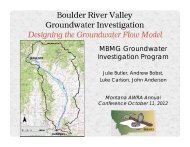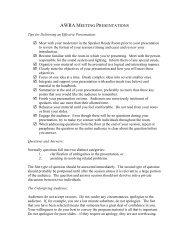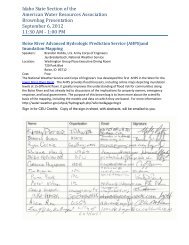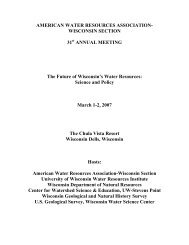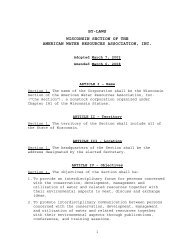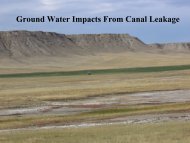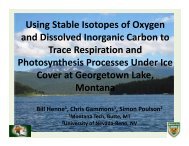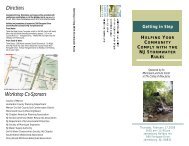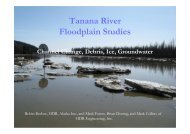Wisconsin's Role in Great Lakes Restoration - American Water ...
Wisconsin's Role in Great Lakes Restoration - American Water ...
Wisconsin's Role in Great Lakes Restoration - American Water ...
Create successful ePaper yourself
Turn your PDF publications into a flip-book with our unique Google optimized e-Paper software.
Us<strong>in</strong>g Risk Calculations to Support Climate Change Adaptation <strong>in</strong> Wiscons<strong>in</strong><br />
**Zachary Schuster, University of Wiscons<strong>in</strong>-Madison, Madison, WI, zschuster@wisc.edu<br />
Kenneth Potter, University of Wiscons<strong>in</strong>-Madison, Madison, WI, kwpotter@engr.wsic.edu<br />
Many studies of the impacts of climate change on precipitation have found that it is very likely<br />
that the magnitude and frequency of <strong>in</strong>tense precipitation events will <strong>in</strong>crease for the<br />
Midwestern United States over the next century. With a consensus coalesc<strong>in</strong>g around these<br />
projected changes, the task for water resource decision-makers now becomes to use that<br />
knowledge to help states and communities prepare adaptation strategies for flood<strong>in</strong>g caused<br />
by a chang<strong>in</strong>g climate.<br />
The goal of this study is to use both climate model precipitation projections and historical<br />
precipitation data to develop a framework for assess<strong>in</strong>g how the precipitation regimes for<br />
Wiscons<strong>in</strong>’s communities are projected to change over the next half-century and how these<br />
projected changes can be used <strong>in</strong> the climate change adaptation process.<br />
The damages caused by <strong>in</strong>tense precipitation events frequently behave non-l<strong>in</strong>early, with the<br />
most <strong>in</strong>tense events caus<strong>in</strong>g a majority of the total damage calculated for a given precipitation<br />
distribution. One method of account<strong>in</strong>g for this non-l<strong>in</strong>earity is by multiply<strong>in</strong>g a damage<br />
function and a precipitation threshold exceedance probability distribution to obta<strong>in</strong> a value of<br />
total risk for a given precipitation record.<br />
This study applies damage functions to statistically-downscaled and de-biased General<br />
Circulation Model (GCM) precipitation data for the state of Wiscons<strong>in</strong> to determ<strong>in</strong>e the<br />
magnitude of projected changes <strong>in</strong> total risk over the next half-century due to climate change.<br />
We then seek to put the model changes <strong>in</strong>to perspective by compar<strong>in</strong>g the total risk<br />
calculated based on Wiscons<strong>in</strong> historical records from 1950-2007 with those calculated for<br />
the other Midwestern states of Ill<strong>in</strong>ois, Iowa, M<strong>in</strong>nesota, and Missouri.<br />
The future temperature regimes for Wiscons<strong>in</strong> are projected to resemble those that currently<br />
occur <strong>in</strong> locations to the south and west of the state. This total risk method allows us to<br />
determ<strong>in</strong>e if similar shifts <strong>in</strong> Wiscons<strong>in</strong>’s precipitation patterns are expected to occur. It also<br />
provides a framework for us<strong>in</strong>g known historical precipitation records from other locations as<br />
the basis for prepar<strong>in</strong>g climate change adaptation strategies for Wiscons<strong>in</strong>’s communities.<br />
** Graduate student presentation<br />
56






